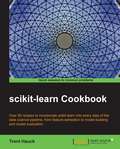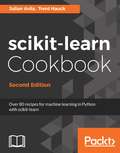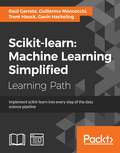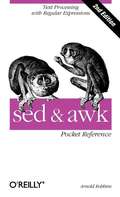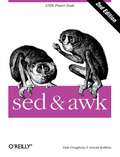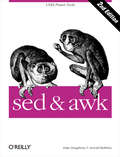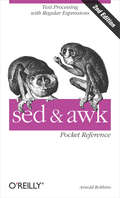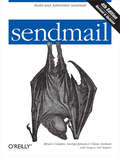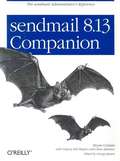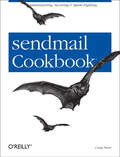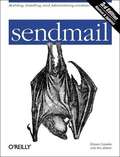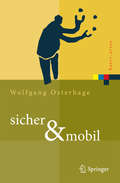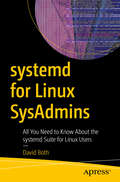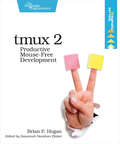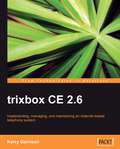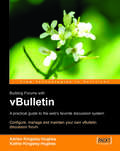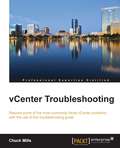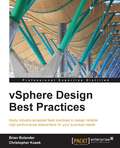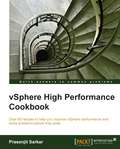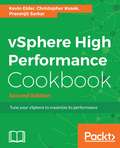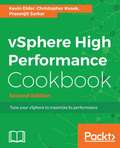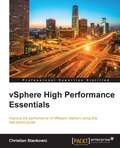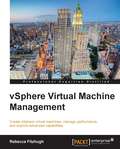- Table View
- List View
scikit-learn Cookbook
by Trent HauckIf you're a data scientist already familiar with Python but not Scikit-Learn, or are familiar with other programming languages like R and want to take the plunge with the gold standard of Python machine learning libraries, then this is the book for you.
scikit-learn Cookbook - Second Edition
by Julian AvilaLearn to use scikit-learn operations and functions for Machine Learning and deep learning applications. About This Book • Handle a variety of machine learning tasks effortlessly by leveraging the power of scikit-learn • Perform supervised and unsupervised learning with ease, and evaluate the performance of your model • Practical, easy to understand recipes aimed at helping you choose the right machine learning algorithm Who This Book Is For Data Analysts already familiar with Python but not so much with scikit-learn, who want quick solutions to the common machine learning problems will find this book to be very useful. If you are a Python programmer who wants to take a dive into the world of machine learning in a practical manner, this book will help you too. What You Will Learn • Build predictive models in minutes by using scikit-learn • Understand the differences and relationships between Classification and Regression, two types of Supervised Learning. • Use distance metrics to predict in Clustering, a type of Unsupervised Learning • Find points with similar characteristics with Nearest Neighbors. • Use automation and cross-validation to find a best model and focus on it for a data product • Choose among the best algorithm of many or use them together in an ensemble. • Create your own estimator with the simple syntax of sklearn • Explore the feed-forward neural networks available in scikit-learn In Detail Python is quickly becoming the go-to language for analysts and data scientists due to its simplicity and flexibility, and within the Python data space, scikit-learn is the unequivocal choice for machine learning. This book includes walk throughs and solutions to the common as well as the not-so-common problems in machine learning, and how scikit-learn can be leveraged to perform various machine learning tasks effectively. The second edition begins with taking you through recipes on evaluating the statistical properties of data and generates synthetic data for machine learning modelling. As you progress through the chapters, you will comes across recipes that will teach you to implement techniques like data pre-processing, linear regression, logistic regression, K-NN, Naive Bayes, classification, decision trees, Ensembles and much more. Furthermore, you'll learn to optimize your models with multi-class classification, cross validation, model evaluation and dive deeper in to implementing deep learning with scikit-learn. Along with covering the enhanced features on model section, API and new features like classifiers, regressors and estimators the book also contains recipes on evaluating and fine-tuning the performance of your model. By the end of this book, you will have explored plethora of features offered by scikit-learn for Python to solve any machine learning problem you come across. Style and Approach This book consists of practical recipes on scikit-learn that target novices as well as intermediate users. It goes deep into the technical issues, covers additional protocols, and many more real-live examples so that you are able to implement it in your daily life scenarios.
scikit-learn: Machine Learning Simplified
by Trent Hauck Raul Garreta Guillermo Moncecchi Gavin HackelingImplement scikit-learn into every step of the data science pipeline About This Book • Use Python and scikit-learn to create intelligent applications • Discover how to apply algorithms in a variety of situations to tackle common and not-so common challenges in the machine learning domain • A practical, example-based guide to help you gain expertise in implementing and evaluating machine learning systems using scikit-learn Who This Book Is For If you are a programmer and want to explore machine learning and data-based methods to build intelligent applications and enhance your programming skills, this is the course for you. No previous experience with machine-learning algorithms is required. What You Will Learn • Review fundamental concepts including supervised and unsupervised experiences, common tasks, and performance metrics • Classify objects (from documents to human faces and flower species) based on some of their features, using a variety of methods from Support Vector Machines to Naive Bayes • Use Decision Trees to explain the main causes of certain phenomena such as passenger survival on the Titanic • Evaluate the performance of machine learning systems in common tasks • Master algorithms of various levels of complexity and learn how to analyze data at the same time • Learn just enough math to think about the connections between various algorithms • Customize machine learning algorithms to fit your problem, and learn how to modify them when the situation calls for it • Incorporate other packages from the Python ecosystem to munge and visualize your dataset • Improve the way you build your models using parallelization techniques In Detail Machine learning, the art of creating applications that learn from experience and data, has been around for many years. Python is quickly becoming the go-to language for analysts and data scientists due to its simplicity and flexibility; moreover, within the Python data space, scikit-learn is the unequivocal choice for machine learning. The course combines an introduction to some of the main concepts and methods in machine learning with practical, hands-on examples of real-world problems. The course starts by walking through different methods to prepare your data—be it a dataset with missing values or text columns that require the categories to be turned into indicator variables. After the data is ready, you'll learn different techniques aligned with different objectives—be it a dataset with known outcomes such as sales by state, or more complicated problems such as clustering similar customers. Finally, you'll learn how to polish your algorithm to ensure that it's both accurate and resilient to new datasets. You will learn to incorporate machine learning in your applications. Ranging from handwritten digit recognition to document classification, examples are solved step-by-step using scikit-learn and Python. By the end of this course you will have learned how to build applications that learn from experience, by applying the main concepts and techniques of machine learning. Style and Approach Implement scikit-learn using engaging examples and fun exercises, and with a gentle and friendly but comprehensive "learn-by-doing" approach. This is a practical course, which analyzes compelling data about life, health, and death with the help of tutorials. It offers you a useful way of interpreting the data that's specific to this course, but that can also be applied to any other data. This course is designed to be both a guide and a reference for moving beyond the basics of scikit-learn.
sed & awk Pocket Reference, 2nd Edition
by Arnold RobbinsThis handy little book is an indispensable reference to information presented in O'Reilly's larger volumes, sed & awk, 2nd Edition and Effective awk Programming. A perfect pocket- sized guide, sed & awk Pocket Reference offers a concise summary of regular expressions and pattern matching, and summaries of sed and awk. The book emphasizes the kinds of practical problems that sed and awk can help users solve, with many example scripts and programs. Also included is a summary of sed and awk's functions and commands, with expanded coverage of TCP/IP networking and internationalization with gawk.
sed & awk Pocket Reference, Second Edition
by Arnold RobbinsThe sed & awk Pocket Reference is a handy, quick reference guide to frequently used functions, commands, and regular expressions used for day-to-day text processing needs. This book is a companion to both sed & awk, Second Edition and Effective awk Programming, Third Edition.
sed & awk, Second Edition
by Arnold Robbins Dale Doughertysed & awk describes two text manipulation programs that are mainstays of the UNIX programmer's toolbox. This edition covers the sed and awk programs as they are mandated by the POSIX standard and includes discussion of the GNU versions of these programs.
sed & awk: UNIX Power Tools
by Arnold Robbins Dale Doughertysed & awk describes two text processing programs that are mainstays of the UNIX programmer's toolbox.sed is a "stream editor" for editing streams of text that might be too large to edit as a single file, or that might be generated on the fly as part of a larger data processing step. The most common operation done with sed is substitution, replacing one block of text with another.awk is a complete programming language. Unlike many conventional languages, awk is "data driven" -- you specify what kind of data you are interested in and the operations to be performed when that data is found. awk does many things for you, including automatically opening and closing data files, reading records, breaking the records up into fields, and counting the records. While awk provides the features of most conventional programming languages, it also includes some unconventional features, such as extended regular expression matching and associative arrays. sed & awk describes both programs in detail and includes a chapter of example sed and awk scripts.This edition covers features of sed and awk that are mandated by the POSIX standard. This most notably affects awk, where POSIX standardized a new variable, CONVFMT, and new functions, toupper() and tolower(). The CONVFMT variable specifies the conversion format to use when converting numbers to strings (awk used to use OFMT for this purpose). The toupper() and tolower() functions each take a (presumably mixed case) string argument and return a new version of the string with all letters translated to the corresponding case.In addition, this edition covers GNU sed, newly available since the first edition. It also updates the first edition coverage of Bell Labs nawk and GNU awk (gawk), covers mawk, an additional freely available implementation of awk, and briefly discusses three commercial versions of awk, MKS awk, Thompson Automation awk (tawk), and Videosoft (VSAwk).
sed and awk Pocket Reference: Text Processing with Regular Expressions
by Arnold RobbinsFor people who create and modify text files, sed and awk are power tools for editing. sed, awk, and regular expressions allow programmers and system administrators to automate editing tasks that need to be performed on one or more files, to simplify the task of performing the same edits on multiple files, and to write conversion programs.The sed & awk Pocket Reference is a companion volume to sed & awk, Second Edition, Unix in a Nutshell, Third Edition, and Effective awk Programming, Third Edition. This new edition has expanded coverage of gawk (GNU awk), and includes sections on:An overview of sed and awk?s command line syntaxAlphabetical summaries of commands, including nawk and gawkProfiling with pgawkCoprocesses and sockets with gawkInternationalization with gawkA listing of resources for sed and awk usersThis small book is a handy reference guide to the information presented in the larger volumes. It presents a concise summary of regular expressions and pattern matching, and summaries of sed and awk.Arnold Robbins, an Atlanta native now happily living in Israel, is a professional programmer and technical author and coauthor of various O'Reilly Unix titles. He has been working with Unix systems since 1980, and currently maintains gawk and its documentation.
sendmail
by Bryan Costales Claus Assmann George Jansen Gregory Neil ShapiroA classic O'Reilly title since 1993, sendmail now covers Versions 8.10 through 8.14 of this email routing program, including dozens of new features, options, and macros. This edition also takes a more nuts-and-bolts approach than its predecessors. It includes both an administration handbook and a reference guide that provide you with clear options for installing, configuring and managing sendmail's latest versions and companion programs. The sendmail program has withstood the test of time because of its ability to solve the mail-routing needs of all sites large or small, complex or simple. But it's also difficult to configure and even more difficult to understand. That's why this book has proven valuable since the dawn of email. With it, you will be able to configure the program to meet any need, so that you never again have to call in a sendmail guru to bail you out.sendmail includes the following sections: Some Basics is especially useful for people new to the program. It covers the basic concepts underlying mail delivery and the roles sendmail plays in that deliveryAdministration covers all aspects of handling sendmail, from downloading and installing new releases to managing mailing lists and aliasesConfiguration Reference contains a heavily cross-referenced guide for configuring and tuning sendmail. Every arcane detail of sendmail is listed alphabeticallyAppendices contain more detail about sendmail than you may ever need This edition also includes new material on SSL and AUTH and a new chapter on Mitlers. If you're interested in what has changed since the last edition, one appendix categorizes the many improvements of sendmail's intervening versions by chapter, complete with references to the appropriate sections and page numbers in the book. With sendmail, system administrators, programmers, network engineers, and even inexperienced users will be able to match this challenging but necessary utility to the needs of their network.
sendmail 8.13 Companion
by Bryan Costales Claus Assmann George Jansen Gregory ShapiroIf you had a list of the words used to describe sendmail, they'd probably include reliable, flexible, configurable, complex, monolithic, and daunting. But you're not likely to find the word easy. Even seasoned sendmail pros are sometimes frustrated by the intricacies of sendmail's configuration files. With a little determination and the help of a good reference book, like sendmail , Third Edition, you can master this demanding program. But when there's a significant point release, like sendmail V8.13, where do you turn? An excellent companion to our popular sendmail , Third Edition, the sendmail 8.13 Companion provides a timely way to document the improvements in V8.13 in parallel with its release. The book highlights the important changes in the latest update to sendmail, pointing out not just what is handy or nice to have, but what's critical in getting the best behavior from sendmail. This is especially important now that spam is on the rise, and because mobile technology requires roving laptops to use encrypted connections. Not surprisingly, many of the changes and additions to V8.13 have been driven by the ongoing fight against spam. Anyone concerned about spam--and who isn't?--will benefit greatly by upgrading to V8.13 sendmail. Among its many enhancements, V8.13 includes new routines that support the SPF sending site authentication standard (in the Milter library), simultaneous connection control, high connection rate control, and finer tuning of SASL parameters. The additions to the Milter library, alone, make upgrading worthwhile, but sendmail's connection control makes it a no-brainer. The key to understanding them is the sendmail 8.13 Companion . The book is divided into twenty-five chapters that parallel the chapters in the third edition of the sendmail book. For instance, if you're interested in Options configuration (Chapter 24 in sendmail), you'll turn to Chapter 24 in your companion volume to find out what's new in V8.13. For a simple dot release (8.12 to 8.13), V8.13 sendmail has added more features, options, and fundamental changes than any other single dot release has included. If you need to set up or manage sendmail, you'll want this companion volume close at hand. Even if you aren't ready to upgrade to V8.13, you'll find the key to understanding them is the sendmail 8.13 Companion a useful guide to understanding and staying current with the latest changes in sendmail.
sendmail Cookbook: Administering, Securing & Spam-Fighting
by Craig HuntMore often than not, the words "sendmail configuration" strike dread in the hearts of sendmail and system administrators--and not without reason. sendmail configuration languages are as complex as any other programming languages, but used much more infrequently--only when sendmail is installed or configured. The average system administrator doesn't get enough practice to truly master this inscrutable technology.Fortunately, there's help. The sendmail Cookbook provides step-by-step solutions for the administrator who needs to solve configuration problems fast. Say you need to configure sendmail to relay mail for your clients without creating an open relay that will be abused by spammers. A recipe in the Cookbook shows you how to do just that. No more wading through pages of dense documentation and tutorials and creating your own custom solution--just go directly to the recipe that addresses your specific problem.Each recipe in the sendmail Cookbook outlines a configuration problem, presents the configuration code that solves that problem, and then explains the code in detail. The discussion of the code is critical because it provides the insight you need to tweak the code for your own circumstances.The sendmail Cookbook begins with an overview of the configuration languages, offering a quick how-to for downloading and compiling the sendmail distribution. Next, you'll find a baseline configuration recipe upon which many of the subsequent configurations, or recipes, in the book are based. Recipes in the following chapters stand on their own and offer solutions for properly configuring important sendmail functions such as:Delivering and forwarding mailRelayingMasqueradingRouting mailControlling spamStrong authenticationSecuring the mail transportManaging the queueSecuring sendmailsendmail Cookbook is more than just a new approach to discussing sendmail configuration. The book also provides lots of new material that doesn't get much coverage elsewhere--STARTTLS and AUTH are given entire chapters, and LDAP is covered in recipes throughout the book. But most of all, this book is about saving time--something that most system administrators have in short supply. Pick up the sendmail Cookbook and say good-bye to sendmail dread.
sendmail, 3rd Edition
by Bryan CostalesThe new edition of sendmailhas been completely revised to cover sendmail 8.12--a version with more features and fundamental changes than any previous version of the Unix-based email routing program. Because the latest version of sendmail differs so significantly from earlier versions, a massive rewrite of this best-selling reference was called for. With sendmail, Third Edition in hand, you will be able to configure this challenging but necessary utility for whatever needs your system requires.
sendmail, 4th Edition
by Bryan Costales Claus Assmann George Jansen Gregory ShapiroA classic O'Reilly title since 1993, sendmail now covers Versions 8.10 through 8.14 of this email routing program, including dozens of new features, options, and macros. This edition also takes a more nuts-and-bolts approach than its predecessors. It includes both an administration handbook and a reference guide that provide you with clear options for installing, configuring and managing sendmail's latest versions and companion programs. The sendmail program has withstood the test of time because of its ability to solve the mail-routing needs of all sites large or small, complex or simple. But it's also difficult to configure and even more difficult to understand. That's why this book has proven valuable since the dawn of email. With it, you will be able to configure the program to meet any need, so that you never again have to call in a sendmail guru to bail you out. sendmail includes the following sections: * Some Basics is especially useful for people new to the program. It covers the basic concepts underlying mail delivery and the roles sendmail plays in that delivery * Administration covers all aspects of handling sendmail, from downloading and installing new releases to managing mailing lists and aliases * Configuration Reference contains a heavily cross-referenced guide for configuring and tuning sendmail. Every arcane detail of sendmail is listed alphabetically * Appendices contain more detail about sendmail than you may ever need This edition also includes new material on SSL and AUTH and a new chapter on Mitlers. If you're interested in what has changed since the last edition, one appendix categorizes the many improvements of sendmail's intervening versions by chapter, complete with references to the appropriate sections and page numbers in the book. With sendmail, system administrators, programmers, network engineers, and even inexperienced users will be able to match this challenging but necessary utility to the needs of their network. This edition also takes a more nuts-and-bolts approach than its predecessors. It includes both an administration handbook and a reference guide that provide you with clear options for installing, configuring and managing sendmail's latest versions and companion programs. The sendmail program has withstood the test of time because of its ability to solve the mail-routing needs of all sites large or small, complex or simple. But it's also difficult to configure and even more difficult to understand. That's why this book has proven valuable since the dawn of email. With it, you will be able to configure the program to meet any need, so that you never again have to call in a sendmail guru to bail you out. sendmail includes the following sections: * Some Basics is especially useful for people new to the program. It covers the basic concepts underlying mail delivery and the roles sendmail plays in that delivery * Administration covers all aspects of handling sendmail, from downloading and installing new releases to managing mailing lists and aliases * Configuration Reference contains a heavily cross-referenced guide for configuring and tuning sendmail. Every arcane detail of sendmail is listed alphabetically * Appendices contain more detail about sendmail than you may ever need This edition also includes new material on SSL and AUTH and a new chapter on Mitlers. If you're interested in what has changed since the last edition, one appendix categorizes the many improvements of sendmail's intervening versions by chapter, complete with references to the appropriate sections and page numbers in the book. With sendmail, system administrators, programmers, network engineers, and even inexperienced users will be able to match this challenging but necessary utility to the needs of their network.
sicher & mobil
by Wolfgang W. OsterhageDie Verlinkung von Computern und ihren Komponenten hat mit den Möglichkeiten der drahtlosen Kommunikation eine neue Qualität erreicht. Die Frage, wie diese Entwicklung die IT-Sicherheit herausfordert, steht im Mittelpunkt des Buchs. Der Autor behandelt die gesamte Bandbreite der drahtlosen Kommunikation (WLAN, Bluetooth, Mobiltelefonie), liefert detaillierte Beschreibungen der Technologie, der Standards, der Verschlüsselung und Konfiguration. Der Band enthält eine Checkliste, die auf den neuesten Sicherheits- und Kommunikationsstandards basiert.
systemd for Linux SysAdmins: All You Need to Know About the systemd Suite for Linux Users
by David BothExplore the world of systemd—yes, all lower-case, even at the beginning of a sentence— which is the modern replacement for init and SystemV init scripts. It is also much more. It can evoke a wide range of reactions from SysAdmins and others responsible for keeping Linux systems up and running. The fact that systemd is taking over so many tasks in modern Linux systems has engendered push-back and discord among certain groups of developers and SysAdmins. You will learn systemd&’s strengths and weaknesses, and why there&’s no truth in the myth that systemd is a monolithic monstrosity.Learn how systemd is the mother of all processes, and is responsible for bringing the Linux host up to a state in which productive work can be done. You&’ll learn about the functions assumed by systemd, which is far more extensive than the old init program, and how it manages many aspects of a running Linux host, including: Mounting filesystems Managing hardware Creating new systemd services and understanding existing ones Creating timers that trigger system maintenance events Starting and managing the system services that are required to have a productive Linux host Using the systemd journal to access critical performance and problem solving information. Why the systemd plan to take over the world is actually a good thing systemd for Linux SysAdmins is your one-stop shop, giving you everythiing you need to get started and utilize this software suite for Linux operatiing systems. You Will Learn: How to use systemd, what it is, and what it does To manage each of the major functional components of systemd and learn from real-world examples to illustrate their typical usage by SysAdmins Pragmatic work-arounds, hints and tricks to minimize issues to ensure you have greater systemd functionality This Book is for: Linux system administrators (SysAdmins) who need to or are already in the process of switching from SystemV to systemd. It&’s also intended for SysAdmins with more systemd experience but who want to improve their knowledge and skills with systemd.
tmux 2: Productive Mouse-Free Development
by Brian P. HoganYour mouse is slowing you down. The time you spend context switching between your editor and your consoles eats away at your productivity. Take control of your environment with tmux, a terminal multiplexer that you can tailor to your workflow. With this updated second edition for tmux 2.3, you'll customize, script, and leverage tmux's unique abilities to craft a productive terminal environment that lets you keep your fingers on your keyboard's home row. You have a database console, web server, test runner, and text editor running at the same time, but switching between them and trying to find what you need takes up valuable time and breaks your concentration. By using tmux 2.3, you can improve your productivity and regain your focus. This book will show you how. This second edition includes many features requested by readers, including how to integrate plugins into your workflow, how to integrate tmux with Vim for seamless navigation - oh, and how to use tmux on Windows 10. Use tmux to manage multiple terminal sessions in a single window using only your keyboard. Manage and run programs side by side in panes, and create the perfect development environment with custom scripts so that when you're ready to work, your programs are waiting for you. Manipulate text with tmux's copy and paste buffers, so you can move text around freely between applications. Discover how easy it is to use tmux to collaborate remotely with others, and explore more advanced usage as you manage multiple tmux sessions, add custom scripts into the tmux status line, and integrate tmux with your system. Whether you're an application developer or a system administrator, you'll find many useful tricks and techniques to help you take control of your terminal.
trixbox CE 2.6
by Kerry GarrisonThis book is a step-by-step tutorial with clear instructions and screenshots to guide you through the creation of a complete, cost-effective telephony system. With its "follow-along" style, you will start with installation, walk through the different features, see how to manage and maintain the system, and finally see how all the different pieces come together. If you want to learn how to install and configure either trixbox CE systems or Asterisk-based PBX systems, without struggling with confusing configuration files and cryptic scripts, this is "the" book for you. This book will also benefit readers who use trixbox CE and want to learn all its features, and how best to use them. It is ideal for any user wishing to set up a telephony system for small business usage. No previous knowledge of Trixbox or networking is required, although some basic knowledge of PBX and Linux would be an advantage.
vBulletin: A Users Guide
by Kathy Kingsley-Hughes Adrian Kingsley-HughesUsing a highly graphical, practical style the experienced authors show you how to get the most out of vBulletin. This book is written for new and intermediate users of vBulletin, who want to manage and maintain a vBulletin discussion forum as easily as possible. No experience of web programming is required.
vCenter Troubleshooting
by Chuck MillsThe book is designed for the competent vCenter administrator or anyone who is responsible for the vSphere environment. It can be used as a guide by vSphere architects and VMware consultants for a successful vSphere solution. You should have good knowledge and an understanding of core elements and applications of the vSphere environment.
vSphere Design Best Practices
by Christopher Kusek Brian BolanderAn easytofollow guide full of handson examples of realworld design best practices. Each topic is explained and placed in context, and for the more inquisitive, there are more details on the concepts used. If you wish to learn about vSphere best practices and how to apply them when designing virtual, high performance, and reliable datacenters that support business critical applications to work more efficiently and to prepare for official certifications, then this is the book for you. Readers should possess a good working knowledge of vSphere as well as servers, storage, and networking.
vSphere High Performance Cookbook
by Prasenjit SarkarvSphere High Performance Cookbook is written in a practical, helpful style with numerous recipes focusing on answering and providing solutions to common, and not-so common, performance issues and problems.The book is primarily written for technical professionals with system administration skills and some VMware experience who wish to learn about advanced optimization and the configuration features and functions for vSphere 5.1.
vSphere High Performance Cookbook - Second Edition
by Prasenjit Sarkar Christopher Kusek Kevin ElderOver 80 recipes to help you improve vSphere 6.5's performance and solve problems before they arise About This Book • The practical recipes provide cost-effective and high performance for any application running in a virtual machine • Contains best practices and troubleshooting techniques to resolve vSphere 6.5 performance issues • Get a comprehensive coverage of performance issues and solutions including vCenter Server design and virtual machine and application tuning Who This Book Is For If you are a system administrator and are planning to deploy vSphere 6.5 in your organization and want to maximize its performance, then this book is for you. Prior knowledge of the vSphere 6.5 concepts is essential. What You Will Learn • Understand the VMM Scheduler, cache aware CPU Scheduler, NUMA aware CPU Scheduler, and more during the CPU Performance Design phase • Get to know the virtual memory reclamation technique, host ballooning monitoring, and swapping activity • Choose the right platform while designing your vCenter Server, redundant vCenter design, and vCenter SSO and its deployment • Learn how to use various performance simulation tools • Design VCSA Server Certificates to minimize security threats • Use health check tools for storage and boost vSphere 6.5's performance with VAAI and VASA In Detail vSphere is a mission-critical piece of software for many businesses. It is a complex tool, and incorrect design and deployment can create performance related issues that can negatively affect the business. This book is focused on solving these problems as well as providing best practices and performance-enhancing techniques. This edition is fully updated to include all the new features in version 6.5 as well as the latest tools and techniques to keep vSphere performing at its best. This book starts with interesting recipes, such as the interaction of vSphere 6.5 components with physical layers such as CPU, memory, and networking. Then we focus on DRS, resource control design, and vSphere cluster design. Next, you'll learn about storage performance design and how it works with VMware vSphere 6.5. Moving on, you will learn about the two types of vCenter installation and the benefits of each. Lastly, the book covers performance tools that help you get the most out of your vSphere installation. By the end of this book, you will be able to identify, diagnose, and troubleshoot operational faults and critical performance issues in vSphere 6.5. Style and approach This cookbook is written in a practical, helpful style with numerous recipes focusing on answering and providing solutions to common and not-so-common performance issues and problems.
vSphere High Performance Cookbook - Second Edition
by Kevin ElderOver 80 recipes to help you improve vSphere 6.5's performance and solve problems before they ariseAbout This Book* The practical recipes provide cost-effective and high performance for any application running in a virtual machine* Contains best practices and troubleshooting techniques to resolve vSphere 6.5 performance issues * Get a comprehensive coverage of performance issues and solutions including vCenter Server design and virtual machine and application tuningWho This Book Is ForIf you are a system administrator and are planning to deploy vSphere 6.5 in your organization and want to maximize its performance, then this book is for you. Prior knowledge of the vSphere 6.5 concepts is essential.What You Will Learn* Understand the VMM Scheduler, cache aware CPU Scheduler, NUMA aware CPU Scheduler, and more during the CPU Performance Design phase* Get to know the virtual memory reclamation technique, host ballooning monitoring, and swapping activity* Choose the right platform while designing your vCenter Server, redundant vCenter design, and vCenter SSO and its deployment* Learn how to use various performance simulation tools* Design VCSA Server Certificates to minimize security threats* Use health check tools for storage and boost vSphere 6.5's performance with VAAI and VASAIn DetailvSphere is a mission-critical piece of software for many businesses. It is a complex tool, and incorrect design and deployment can create performance related issues that can negatively affect the business. This book is focused on solving these problems as well as providing best practices and performance-enhancing techniques. This edition is fully updated to include all the new features in version 6.5 as well as the latest tools and techniques to keep vSphere performing at its best.This book starts with interesting recipes, such as the interaction of vSphere 6.5 components with physical layers such as CPU, memory, and networking. Then we focus on DRS, resource control design, and vSphere cluster design. Next, you'll learn about storage performance design and how it works with VMware vSphere 6.5. Moving on, you will learn about the two types of vCenter installation and the benefits of each. Lastly, the book covers performance tools that help you get the most out of your vSphere installation.By the end of this book, you will be able to identify, diagnose, and troubleshoot operational faults and critical performance issues in vSphere 6.5.Style and approachThis cookbook is written in a practical, helpful style with numerous recipes focusing on answering and providing solutions to common and not-so-common performance issues and problems.
vSphere High Performance Essentials
by Christian StankowicImprove the performance of VMware vSphere using this fast-paced guide About This Book * Design, configure, and monitor your virtual landscape to run performance-intensive workloads * Implement a reliable and high-performance network for virtual infrastructures with confidence. * Investigate and eliminate virtual machine performance issues Who This Book Is For If you're a system administrator who has some experience with VMware vSphere but would like a quick guide to be able to identify and fix performance issues in your vSphere systems, then this book is for you. What You Will Learn * Choose the right hardware and server components suitable for high-performance scenarios * Adopt availability and automatic load-balancing in your virtual infrastructure * Understand and monitor CPU and memory resources * Monitor performance on the vCenter, ESXi, and virtual machine levels * Configure storage resources to achieve greater performance * Incorporate latency and performance sensible networking * Tune and tweak common guest operating systems In Detail VMware vSphere is all the components and operating system that comes together to make VMware's enterprise virtualization platform unique. When running enterprise-driven application workloads, the VMware vSphere family has become a preference of many developers. The vSphere platform is designed to work with numerous servers and infrastructure core components to create virtualized platforms and/or a complete cloud computing fabrics. This book will guide you through tuning, tweaking, and optimizing vSphere in order to improve the performance of your systems. It will also help you identify and fix common performance bottlenecks. Starting with planning high-performance infrastructure setups, the book covers the core concepts of cluster setups such as resource pools, DRS, and availability options, along with CPU virtualization concepts. Next, it covers the management of physical and virtual memory mechanisms, swapping, and ballooning. Moving on, you'll get an understanding of how vCenter Server can assist you with recognizing performance issues, and how to utilize advanced technologies such as Storage I/O Control and vSphere Flash Read Cache to tune storage resources. Next, you'll learn to implement a reliable and high-performance network for virtual infrastructures. Finally, the book shows you how esxtop and resxtop can provide advanced metrics to detect performance issues, and how you can optimize storage and network resources inside virtual machines. Style and approach This book is a step-by-step guide, but at a fast pace. It explains high-performing VMware vSphere infrastructure setups and workloads through real-world examples.
vSphere Virtual Machine Management
by Rebecca FitzhughThis book follows a step-by-step tutorial approach with some real-world scenarios that vSphere businesses will be required to overcome every day. This book also discusses creating and configuring virtual machines and also covers monitoring virtual machine performance and resource allocation options. This book is for VMware administrators who want to build their knowledge of virtual machine administration and configuration. It's assumed that you have some experience with virtualization administration and vSphere.
